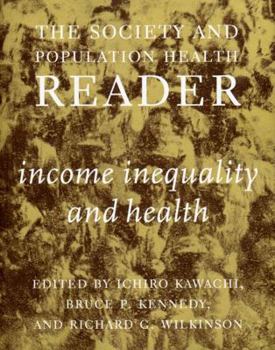Income Inequality and Health
The first volume in the groundbreaking and controversial two-volume reader on the connections between social structure and public health. This description may be from another edition of this product.
Format:Paperback
Language:English
ISBN:1565845714
ISBN13:9781565845718
Release Date:November 1999
Publisher:New Press
Length:505 Pages
Weight:2.10 lbs.
Dimensions:1.4" x 7.2" x 9.2"
Customer Reviews
1 rating
Review in the New England Journal of Medicine
Published by Thriftbooks.com User , 24 years ago
According to the United Nations Human Development Report published in 1996, the 358 richest persons on earth control assets equivalent to the annual income of 45 percent of the world's population. In the United States, the top 1 percent of income earners receives 12 percent of the entire country's pretax income and holds 37 percent of the wealth. At the same time, evidence is accumulating that disparities in income have profound social consequences and that the social and economic structure of a society may fundamentally determine the health of its members. The Society and Population Health Reader provides the reader with the original reports on income inequality and its effects on public health. That being poor is associated with ill health would seem to go without saying. Many studies in the past three decades have established that absolute levels of income or education or class are related to morbidity and mortality. The Whitehall studies of the British civil service, begun in 1967, showed that mortality rates were three times as high among people in the lowest employment grades (porters) than among those in the highest grades (administrators) in a relatively homogeneous population of office-based civil servants who had access to comprehensive health care. The Whitehall studies and the Multiple Risk Factor Intervention Trial in the United States show that conventional risk factors (smoking, obesity, inactivity, and high blood pressure) explain only 25 to 35 percent of the differences in mortality rates among persons of different incomes. In fact, socioeconomic status is now understood to be the single most powerful determinant of health. This in itself is a stunning notion --one that is overlooked by physicians who are not oriented to population health. Physicians are accustomed to think of the socioeconomic determinants of disease in terms of an individual person's risk factors. The story, revealed in these collected papers, is more complex. It now seems clear that absolute wealth or income is a less important determinant of health than the relative disparity in income or the income gap between the rich and the poor. Wilkinson is a leading proponent of the relative-income hypothesis. He finds no clear relation between income and health when comparisons are made between countries. For example, there is no relation between the per capita gross domestic product and life expectancy at birth in comparisons among developed countries with similar levels of industrialization. Wilkinson and now a number of other scientists have, however, found a strong relation between income inequality and health. Countries with the longest life expectancy -- Japan, Iceland, and France -- are not necessarily the wealthiest, but they are the countries with the least income inequality. These relations are not limited to nations but can also be seen at regional and local levels. In the United States, for example, states with the nar




